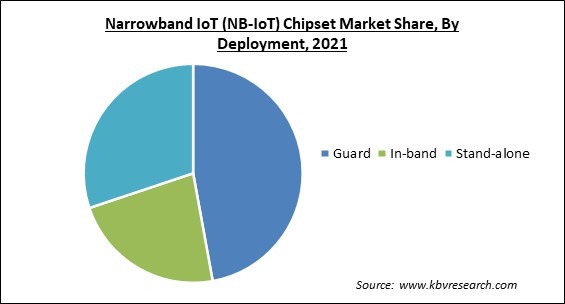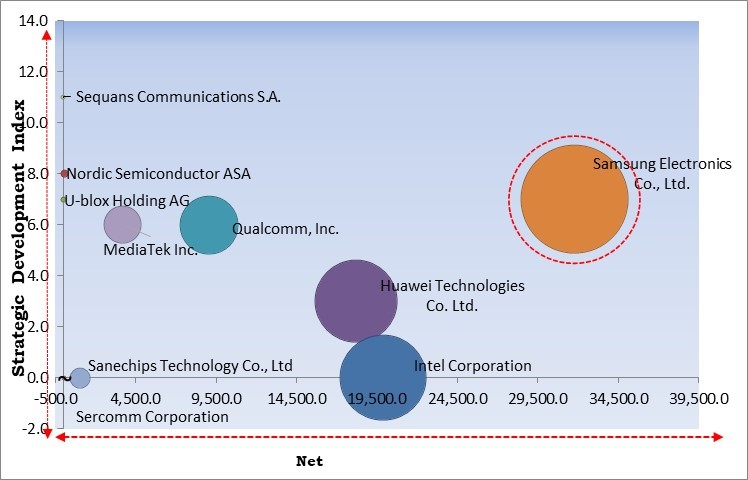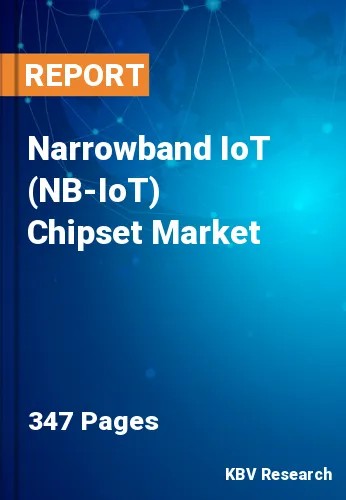The Global Narrowband IoT (NB-IoT) Chipset Market size is expected to reach $7.7 billion by 2028, rising at a market growth of 51.6% CAGR during the forecast period.
A tiny electrical component known as a Narrowband IoT (NB-IoT) chipset is used in many machines, electronic gadgets, and physical items. Due to numerous advantages of the technology, including low power consumption for user devices, high system capacity, and improved spectrum efficiency enabling deep coverage of an area, the narrowband IoT chipset market is expanding at a rapid rate. A wide variety of new Internet of Things (IoT) devices and services are made possible by the standards-based low power wide area (LPWA) technology known as narrowband Internet of Things (NB-IoT).

In deep coverage, NB-IoT dramatically increases spectrum efficiency, system capacity, and user device power consumption. A variety of use cases can accommodate a battery life of more than 10 years. The technologies utilized to transport data nowadays range widely. Each has distinct advantages and disadvantages, and the appropriate technology is selected based on the specific circumstances.
The most discussed in recent years and one that will be widely used in future years across multiple industries is NB-IoT (Narrowband Internet of Things). A lot of devices can communicate data using the NB-IoT technology even in areas without coverage from a typical mobile network. A more reliable data transport is ensured by the use of a licensed frequency band where there is no interruption from other devices. A network that can span over big regions while using less energy is an LPWAN, and this is what the NB-IoT is.
As lockdowns were imposed all over the world and the continuity of operations for the majority of industries is significantly compromised, the COVID-19 pandemic is having a significant impact on global supply chains and logistics. Several nations have halted all imports as a result of the COVID-19 pandemic out of concern for further viral spread. The pandemic is anticipated to cause a decrease in the availability of connectivity devices, which would cause the rate of growth of the NB-IoT chipset market to be slower than anticipated. Moreover, the market for smart street lighting has been impacted by the expansion of COVID-19, which has also had an impact on investments in smart cities and infrastructure projects for roads and highways.
Battery life is a major aspect in the world of IoT devices as well as other connected devices today. Smartphone makers are continuously striving to improve their devices' massive battery life because modern smartphones are so different from their models from only a few years ago. Technologies are evolving and becoming more advanced and sophisticated every year. The market for connected devices is expanding, particularly in the industrial sector, as M2M communications become more prevalent. In addition, connectivity has been made possible by market trends, like IoT in practically every sector, encompassing healthcare, consumer electronics, or retail.
Companies would not make significant investments in new technology if it does not improve their bottom line in the long run. That is actually how it should be because a business is fundamentally a living entity that is trying to survive in a hostile market where cost is a very significant factor for the growth and revenue of any business. With the rapidly expanding information infrastructure and the world's economy being so interconnected, this is more relevant than ever. NB-IoT and similar technologies use a fairly straightforward waveform, which uses less power. But it's not only about power savings. As NB-IoT becomes more and more popular, making NB-IoT chips will become more and more affordable.
Compared to LTE-M, NB-IoT is less suitable for situations where very low network latency is required. In situations where near-real-time data could be necessary, where LTE-M is a better fit, it will therefore be less common. In the transition to 5G, both NB-IoT and LTE-M play a role in enabling use cases that demand speed and are frequently crucial. Not all of this depends on the communication standard that is selected. For fixed or mobile devices, NB IoT was created as a pure data transfer method. It cannot seamlessly switch between cells and cannot serve applications that need low latency.
By Offering, the Narrowband IoT (NB-IoT) Chipset Market is divided into Hardware and Software. In 2021, the software segment garnered a substantial revenue share of the narrowband IoT chipset market. The rise in the growth of the segment is owing to the increasing number of technological advancements in the technology. Narrowband IoT chipset-integrated software is increasingly becoming more sophisticated, which is allowing the incorporation of a large number of advanced technologies in individual software. Therefore, the growth of the market is being majorly stimulated.

On the basis of Deployment, the Narrowband IoT (NB-IoT) Chipset Market is segmented into Guard, In-band, and Standalone. In a guard deployment scenario, operators install NB-IoT in guard bands using the available LTE spectrum. The rapidly increasing growth of the segment is primarily owing to the increased efficiency of this type of deployment. In addition, guard deployment is also cost-effective, due to which, they are being majorly integrated into affordable devices in several countries and therefore, the growth of the segment is booming.
By Application, the Narrowband IoT (NB-IoT) Chipset Market is classified into Smart Meters, Smart Parking, Trackers, Alarms & Detectors, Wearable Devices, and Other Devices. The surging growth of the segment is attributed to the widespread urbanization all over the world. With an increasing number of people migrating to urban areas, the demand for smart homes is on a rise, which is leading to a boom in the adoption of smart meters. Due to the lightweight and compact nature of narrowband IoT chipsets, they are being increasingly deployed in smart meters. This factor is bolstering the growth of the segment.
Based on Vertical, the Narrowband IoT (NB-IoT) Chipset Market is categorized into Agriculture, Automotive & Transportation, Energy & Utilities, Healthcare, Infrastructure, and Others. In 2021, the agriculture segment emerged as the fastest-growing segment of the narrowband IoT chipset market. The surge in the growth of the segment is majorly due to the increasing growth of the agriculture industry. The utilization of narrowband IoT chipsets is rapidly increasing for the safety and security of fields and farms. Therefore, the growth of the segment is being significantly augmented.
| Report Attribute | Details |
|---|---|
| Market size value in 2021 | USD 486.6 Million |
| Market size forecast in 2028 | USD 7.7 Billion |
| Base Year | 2021 |
| Historical Period | 2018 to 2020 |
| Forecast Period | 2022 to 2028 |
| Revenue Growth Rate | CAGR of 51.6% from 2022 to 2028 |
| Number of Pages | 347 |
| Number of Tables | 583 |
| Report coverage | Market Trends, Revenue Estimation and Forecast, Segmentation Analysis, Regional and Country Breakdown, Competitive Landscape, Companies Strategic Developments, Company Profiling |
| Segments covered | Offering, Deployment, Vertical, Application, Region |
| Country scope | US, Canada, Mexico, Germany, UK, France, Russia, Spain, Italy, China, Japan, India, South Korea, Singapore, Malaysia, Brazil, Argentina, UAE, Saudi Arabia, South Africa, Nigeria |
| Growth Drivers |
|
| Restraints |
|
Region-Wise, the Narrowband IoT (NB-IoT) Chipset Market is analyzed across North America, Europe, Asia-Pacific, and LAMEA. In 2021, Asia-Pacific held the highest revenue share of the narrowband IoT chipsets market. The growth of the regional market is ascribed to the rapid development of infrastructure across the region as the regional countries are in their developing phase. Moreover, the widespread urbanization in the region is also a crucial factor complementing the growth of the regional market. The market in this region is being driven by the booming agricultural industry of India.
Free Valuable Insights: Global Narrowband IoT (NB-IoT) Chipset Market size to reach USD 7.7 Billion by 2028

The major strategies followed by the market participants are Partnerships. Based on the Analysis presented in the Cardinal matrix; Samsung Electronics Co., Ltd. is the forerunner in the Narrowband IoT (NB-IoT) Chipset Market. Companies such as Huawei Technologies Co. Ltd., Qualcomm, Inc. and Intel Corporation are some of the key innovators in Narrowband IoT (NB-IoT) Chipset Market.
The market research report covers the analysis of key stake holders of the market. Key companies profiled in the report include Samsung Electronics Co., Ltd., Intel Corporation, U-blox Holding AG, Sequans Communications S.A., Huawei Technologies Co. Ltd., Qualcomm, Inc., Nordic Semiconductor ASA, MediaTek, Inc., Sercomm Corporation and Sanechips Technology Co., Ltd.
By Application
By Deployment
By Offering
By Vertical
By Geography
The Narrowband IoT (NB-IoT) Chipset Market size is projected to reach USD 7.7 billion by 2028.
Increasing Adoption of IOT Along With Better Battery Life for Other Connected Devices are driving the market in coming years, however, Incompatibility with High Data Speeds Along With the Availability of Alternatives Across The Market restraints the growth of the market.
Samsung Electronics Co., Ltd., Intel Corporation, U-blox Holding AG, Sequans Communications S.A., Huawei Technologies Co. Ltd., Qualcomm, Inc., Nordic Semiconductor ASA, MediaTek, Inc., Sercomm Corporation and Sanechips Technology Co., Ltd.
The Hardware market is leading the Global Narrowband IoT (NB-IoT) Chipset Market by Offering in 2021, thereby, achieving a market value of $5.4 billion by 2028.
The Alarms & Detectors market shows high market in Global Narrowband IoT (NB-IoT) Chipset Market by Application in 2021, thereby, achieving a market value of $2.0 billion by 2028.
The Asia Pacific market dominated the Global Narrowband IoT (NB-IoT) Chipset Market by Region in 2021, thereby, achieving a market value of $2.9 billion by 2028.
Our team of dedicated experts can provide you with attractive expansion opportunities for your business.

